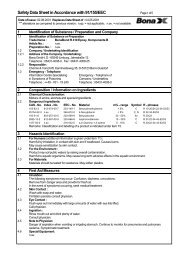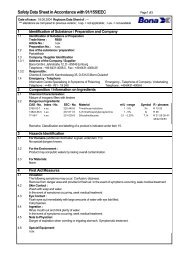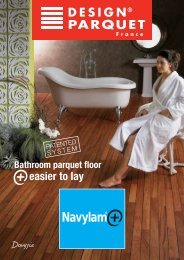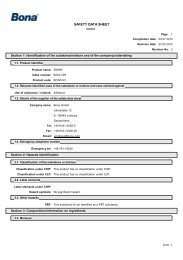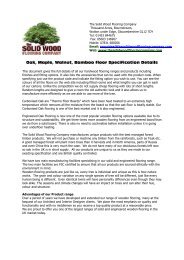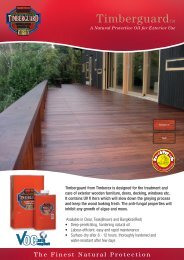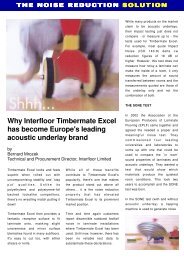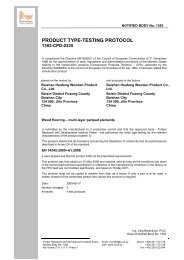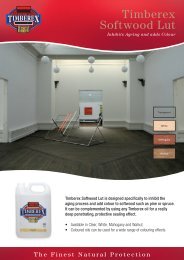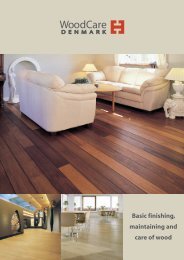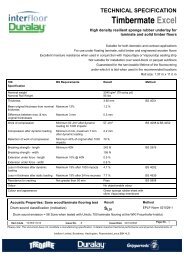Loading for buildings â - Solid Wood Flooring Company
Loading for buildings â - Solid Wood Flooring Company
Loading for buildings â - Solid Wood Flooring Company
You also want an ePaper? Increase the reach of your titles
YUMPU automatically turns print PDFs into web optimized ePapers that Google loves.
BS 6399-1:1996<br />
12 Accidental load on key or protected elements<br />
When an accidental load is required <strong>for</strong> a key or protected element approach to design, 2) that load shall be<br />
taken as 34 kN/m 2 .<br />
Table 4 — Minimum horizontal imposed loads <strong>for</strong> parapets, barriers and balustrades, etc.<br />
Type of occupancy <strong>for</strong><br />
part of the building or<br />
structure<br />
Examples of specific use<br />
Horizontal<br />
uni<strong>for</strong>mly<br />
distributed line<br />
load<br />
A uni<strong>for</strong>mly<br />
distributed load<br />
applied to the<br />
infill<br />
A point load<br />
applied to part<br />
of the infill<br />
Licensed copy:Allies and Morrison, 22/03/2010, Uncontrolled Copy, © BSI<br />
A Domestic and<br />
residential activities<br />
B and E Offices and work<br />
areas not included<br />
elsewhere including<br />
storage areas<br />
C Areas where people<br />
may congregate<br />
C1/C2 Areas with tables<br />
or fixed seating<br />
C3 Areas without<br />
obstacles <strong>for</strong> moving<br />
people and not<br />
susceptible to<br />
overcrowding<br />
C5 Areas susceptible to<br />
overcrowding<br />
D Retail areas<br />
F/G Vehicular<br />
Note deleted.<br />
2) See appropriate material design code.<br />
(i) All areas within or serving exclusively one<br />
single family dwelling including stairs,<br />
landings, etc. but excluding external<br />
balconies and edges of roofs (see C3 ix)<br />
(kN/m) (kN/m 2 ) (kN)<br />
0.36 0.5 0.25<br />
(ii) Other residential, (but also see C) 0.74 1.0 0.5<br />
(iii) Light access stairs and gangways not<br />
more than 600 mm wide<br />
(iv) Light pedestrian traffic routes in<br />
industrial and storage <strong>buildings</strong> except<br />
designated escape routes<br />
(v) Areas not susceptible to overcrowding in<br />
office and institutional <strong>buildings</strong> also<br />
industrial and storage <strong>buildings</strong> except as<br />
given above<br />
(vi) Areas having fixed seating<br />
within 530 mm of the barrier, balustrade or<br />
parapet<br />
0.22 N/A N/A<br />
0.36 0.5 0.25<br />
0.74 1.0 0.5<br />
1.5 1.5 1.5<br />
(vii) Restaurants and bars 1.5 1.5 1.5<br />
(viii) Stairs, landings, corridors, ramps 0.74 1.0 0.5<br />
(ix) External balconies and edges of roofs.<br />
Footways and pavements within building<br />
curtilage adjacent to basement/sunken areas<br />
0.74 1.0 0.5<br />
(x) Footways or pavements less than 3 m<br />
wide adjacent to sunken areas<br />
(xi) Theatres, cinemas, discotheques, bars,<br />
auditoria, shopping malls, assembly areas,<br />
studio. Footways or pavements greater<br />
than 3 m wide adjacent to sunken areas<br />
1.5 1.5 1.5<br />
3.0 1.5 1.5<br />
(xii) Grandstands and stadia<br />
See requirements of the appropriate certifying authority<br />
(xiii) All retail areas including public areas of 1.5 1.5 1.5<br />
banks/building societies or betting shops. For<br />
areas where overcrowding may occur, see C5<br />
(xiv) Pedestrian areas in car parks including<br />
stairs, landings, ramps, edges or internal<br />
floors, footways, edges of roofs<br />
(xv) Horizontal loads imposed by vehicles See clause 11<br />
1.5 1.5 1.5<br />
© BSI 11 October 2002<br />
9




